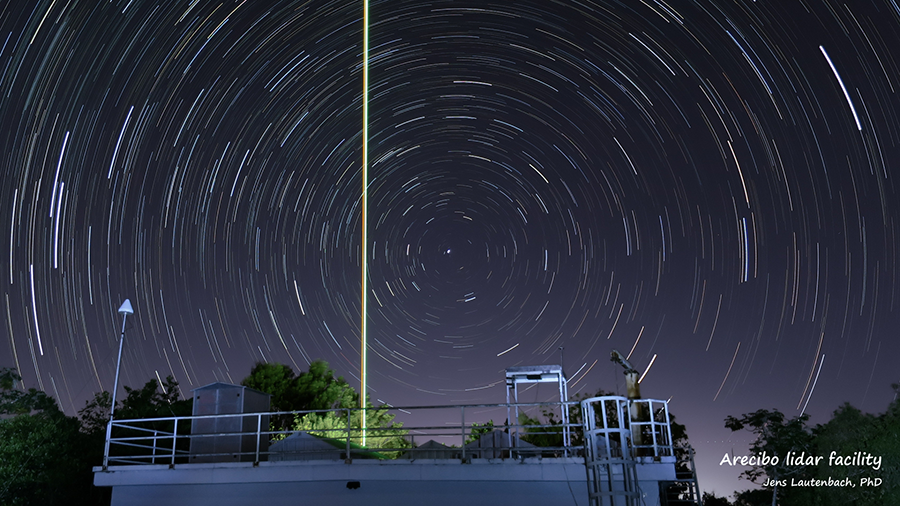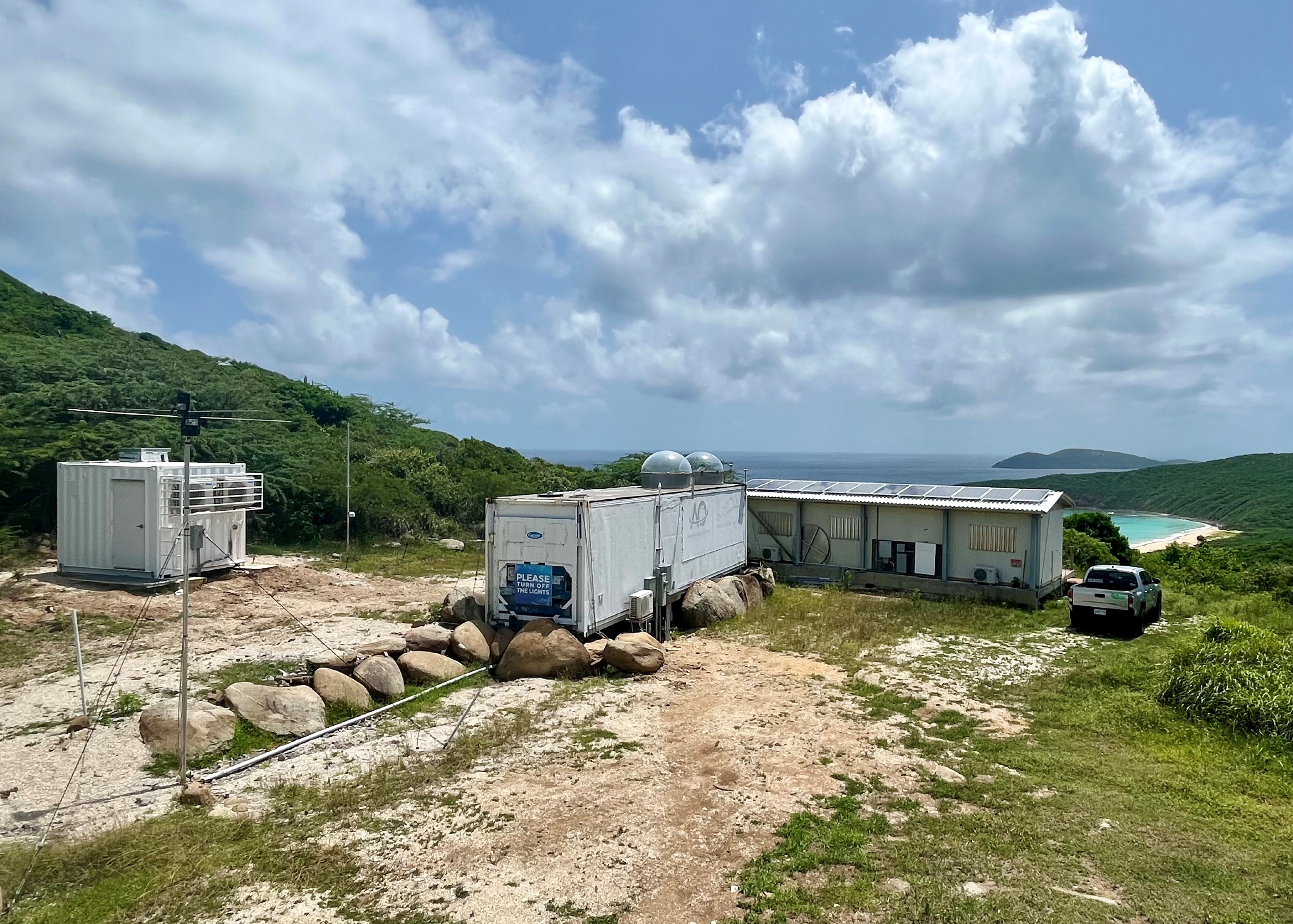The Future of AO Facilities and Science Programs
Science operations at the Arecibo Observatory ceased as of August 14th 2023. The facility is expected to transition to the Arecibo Center for STEM Education and Research (ASCER) in the future.
The Puerto Rican-based company GENCO General Contractors has been hired to maintain parts of the facility.
What will happen with the existing Arecibo Observatory facilities and science programs?
Table of Contents
- 305-m William E. Gordon Telescope
- 12-meter Telescope
- e-Callisto
- Arecibo LIDAR Facility (ALF)
- Caribbean Climate Open Research and Education (CCORE) Center; formerly the Remote Optical Facility (ROF)
- Puerto Rican Initiative for Studies using Meteor Radar (PRISMA)
- Culebra Aerosol Research LIDAR (CARLA)
- Arecibo Planetary Radar Program
- What's next for the site of the Arecibo Observatory?
305-m William E. Gordon Telescope

Following the collapse of the 305-m telescope, a team of scientists and historians from the AO Science and Visitor’s Center, the Smithsonian Institution, NSF, and AO users and staff formed the Arecibo Observatory Survey Salvage Committee. Many of the items salvaged are on display along the road to the Àngel Ramos Foundation Science & Visitor Center.
Read more:
The Arecibo Observatory Survey Salvage Committee
Read the official Arecibo Observatory Survey
Committee Report: AOSSC Report & Recommendations
For more information related to any future plans for the 305-m telescope, we refer you to the National Science Foundation.
12-meter Telescope

The 12-m radio telescope has undergone significant upgrades in the past five years, including the very recent upgrade to install and operate the front-end cryogenic receiver. Read more about the 12-m science highlights and the recent cryogenic system upgrade.
The National Science Foundation has documented how the 12-m telescope is initialized and functions so that it may be used in the future. It is one of the facilities that has been placed in long-term storage. The NSF has also stated that proposals to use the 12-m telescope will be accepted by the NSF, provided the users request sufficient funds to operate the telescope. It has not been communicated to the AO staff if or how the facility will be maintained between such funded observational programs. . For questions, we recommend you reach out to the NSF directly.
There are parties interested in the continued use of the 12-m telescope, including the Center for Advanced Research in Science and Engineering (CARSE) at the University of Puerto Rico Mayaguez that had established collaborations with AO staff to use the 12-m telescope with the Arecibo Observatory.
e-Callisto
AO Callisto was part of the e-Callisto network, an International Space Weather Initiative (ISWI) instrument to monitor space weather, initiated by the United Nations Office for Outer Space Affairs (UNOOSA) and NASA. The AO Callisto program was led by Dr. P. K. Manoharan. The two CALLISTO instruments at AO always produced solar radio burst data sets (dynamic spectra in circular polarisation) with extremely good quality. AO Callisto was special in terms of signal to noise ratio as well as of very low radio interference. AO Callisto data sets were made available online at every 30-min intervals at https://e-callisto.org/Data/data.html. The data sets were used and are being used in scientific studies dealing with solar events and space weather phenomena. As one can see on the monthly statistics, AO Callisto was always located best among the worldwide network of Callisto regarding: (i) number of bursts detected which is a quality measure, (ii) lesser radio interference, and (iii) good instrument sensitivity. The system was very well maintained. Along with the 12-m telescope solar mapping, preliminary space weather forecasts of fast/wide coronal mass ejections (CMEs) were enabled and such forecasts motivated a number of researchers to look for and understand solar events.
There was a request to install the existing e-Callisto system on the CCORE site at Culebra; however this request was not granted. It is now in “long-term” storage at the site of the Arecibo Observatory.

Arecibo LIDAR Facility (ALF)

As with the 12-m and 305-m radio dishes, the LIDAR laboratory has been placed into long-term storage. This includes the equipment within the LIDAR facility, including the new lasers that had recently been purchased, tested, and operated. AO scientists noted that after Hurricane Maria, the lack of a temperature-controlled environment resulted in misalignment of the very sensitive optics of the LIDAR facilities that required weeks to months to resolve. It is not clear if the facility will be able to maintain the needed temperatures for the LIDAR system to be used in the future.
Caribbean Climate Open Research and Education (CCORE) Center; formerly the Remote Optical Facility (ROF)
CCORE, formerly called the Remote Optical Facility (ROF), will continue to operate following the closure of the Arecibo Observatory. After the announcement of the end of operations of the AO as a research facility, the AO-ROF was renamed to CCORE. This change implies the detachment of the facility from AO and the beginning of an operational model based on open research data dissemination and self-funded sustainability with support from the University of Central Florida.
CCORE is an optimal environment for optical and radio instruments due to its very low levels of radio frequency interference, low light contamination, and little cloud coverage.
Since 2018, the facility has been in continuous operation and expansion. As a long-term plan, CCORE is expected to be an interdisciplinary hub for climate investigations of the Earth’s atmosphere and Space. With the end of AO operations, CCORE will host some of the passive optical instruments and radio receivers previously hosted at AO. This initiative aims to (1) continue the legacy of Space & Atmospheric Science (SAS) in Puerto Rico without interruptions to the extensive database; (2) support active grants and projects that depend on the existing instruments; (3) establish new collaborations with local, mainland and international scientists; and (4) bring new funding opportunities to operate CCORE in order to continue the cutting-edge SAS research opportunities in Puerto Rico.
CCORE is in the Department of Energy’s ESPCoR jurisdiction of Puerto Rico and it is aligned with the jurisdiction mission of enhancing the research competitiveness on the Island. The research activity at CCORE may serve as a seed for future infrastructure development in Culebra, a remote region of Puerto Rico with a poverty rate of 23%. Previously, NSF data revealed that Latin-American participation in geosciences does not represent the US population (Bernard and Cooperdok, 2018). With the end of operations of the AO Cooperative Agreement, the under representation of Latin Americans in the space science field will likely increase even further. The proposed activities at CCORE will help mitigate this impact.
CCORE is open for new collaborations. If you need more information please contact Dr. Pedrina Terra. Dr. Terra is now a research scientist with the Florida Space Institute.


Puerto Rican Initiative for Studies using Meteor Radar (PRISMA)
The PRISMA meteor radar has been operating at the Caribbean Climate Open Research and Education (CCORE) center (unit 2) on the island of Culebra, Puerto Rico since February 2023. It is funded by the Advance Research Grants Program from Puerto Rico Science, Technology & Research Trust.
PRISMA’s goals are to determine the meteor’s climatology in Puerto Rico vicinities and the meteor flux properties, aiding research in planetary, meteor, and atmospheric sciences. PRISMA will also evaluate the potential of using meteor radar to study space debris, providing new tools to support the local space environment’s protection.
For more information about the PRISMA project please contact PI Dr. Pedrina Terra.

Culebra Aerosol Research LIDAR (CARLA)
The Culebra Aerosol Research LIDAR (CARLA) is an innovative light detection and ranging instrument (LIDAR) designed to provide aerosol data to student the Saharan dust at a Caribbean location and provide increased educational outreach opportunities to Puero Rico’s K-12 schools and university students (Read More).
Following the completion of the two-year grant from the Puerto Rico Science, Technology & Research Trust to support the development and commissioning of the instrumentation, CARLA has been packed and shipped to the small island of Culebra, 17 miles off the coast of mainland Puerto Rico. The lead for the facility, Dr. Jens Lautenbach, is currently seeking grant opportunities and/or institutions with interest in financially supporting the operation of this facility into the future. If interested, contact Dr. Lautenbach.



Arecibo Planetary Radar Program
The Planetary Radar Program has been funded through grants administered by NASA. Recent grants selected by NASA will continue to fund some of the ongoing data analysis of radar data collected at the observatory, much of which will be carried out at the University of Central Florida and the Florida Space Institute; future AO radar analyses will depend on the successful acquisitions of grants from the available NASA programs or appropriate programs offered through other agencies such as the NSF.
Read here for highlights from the planetary radar program
What's next for the site of the Arecibo Observatory?
The science community recognizes the importance of the site of the Arecibo Observatory for the purposes of science and education. We hope for the opportunity to consider rebuilding an even more powerful telescope at the site in the future. One possible design is the Next Generation Arecibo Telescope (NGAT), described in great detail in a White Paper led by Dr. Anish Roshi, Head of Astronomy at AO.
It has been a very difficult and emotional period for those who worked at the Arecibo Observatory - many of whom were there for decades, for those who have ever used the telescope to explore the cosmos, and for many who live in Puerto Rico. The community still has hope for a future, though the path would be difficult. Some of those thoughts are captured in this article published by Nature.
